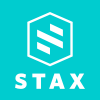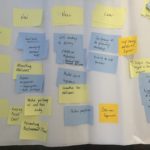Thanks to Aconex, UX Melbourne and the UX Design Group of Melbourne for inviting Jim Kalbach out to Oz and pairing with us to host this event.
Jim is the author of 2 books: Designing Web Navigation and his latest Mapping Experiences. Our focus for the evening was mapping experiences.
Currently, Jim works at MURAL which helps teams design together when they are working remotely. He started out as a librarian, moved into the information architecture direction – which finally landed him in the UX space. He spent some time at Citrix leading with the design experience across the SaaS communications cloud.
[pullquote]”Start with the customer experience and work back to the technology, not the other way around” Steve Jobs, 1996[/pullquote]
Getting the Apple reference out of the way early :-), Jim talked about the need for the customer to come first with everything you do which will in turn create value for the business. Steve Jobs wasn’t the first to talk about this concept though as Jim shared a reference from Theodore Levitt.
[pullquote]“that businesses will do better in the end if they concentrate on meeting customers’ needs rather than on selling products.” Theodore Levitt, 1960[/pullquote] In 1960, Theodore coined the term ‘Marketing Myopia’ and talked about the value comes from the customer.
With the scene set for customer focus, Jim took us through his four principles.
- Survival requires a reversal in business thinking: start with the experience and creates value from there.
- The aspiration of design should be more than “delight”. We help re-align the business perspective by visualising (actual) value.
- Mapping experiences leverages our design skills to become facilitators and grass roots leaders in the organisation
- Shift your measure of progress from generating and testing ideas to validated learning about your riskiest assumptions.
Survival requires a reversal in business thinking: start with the experience and create value from there.
Maps help with visualising value.
A beautiful example Jim used showed the process of buying a house, mapped out by Sofia Hossain. Sofia uses a circular style for her visualisations which really stands out. This style also shows the contribution of external vs internal activities
Most of the experiences a customer has will repeat themselves. There may be a long time between buying your first house til the next time but the cycle starts again in the same way each time.
An example of her work on planning events is here. .
The individual and the organisation overlap by a certain amount and that overlap is where the “exchange of value” occurs. This set of interactions or touch points is where it can all go marvelously wrong or beautifully right. If you don’t understand what these are you can only keep throwing solutions at symptoms instead of fixing the problem permanently.
This is where Alignment Diagrams become are great. They’re useful and important to help you understand these points of interaction plus help you communicate the situation to others in your organisation. Use them to help build brilliant products & to communicate what needs to be involved to resolve problems faced by the customer.
A couple of examples of different ways to do customer experience maps included mental models (Indi Young) and spatial maps (Paul Kahn), but anything that makes it visual and drives conversation falls into the group of alignment diagrams.
The aspiration of design should be more than “delight”: We help re-align the business perspective by visualising (actual) value.
The designer needs to be a facilitator for a broader conversation in the organisation.
You are driving all the steps:
- Initiate
- Investigate
- Illustrate
- Align
- Envision
An experience map by being visual and drawn together in a collaborative way becomes a “campfire that draws people in” to talk and huddle over. This metaphor is particularly powerful to remember the purpose of these efforts and a reminder that if a team is working on a map but it is hidden away in a room where no one can see it, then it isn’t doing its job.
One has to follow through with the information gathered and run experiments to prove a solution will work. It is pretty easy these days to prototype, test and thus learn. Be careful with your definition of MVP…..
Again a process to encourage Empathy, expand out to Envision, converge again as you Evaluate and then Plan experiments to learn.
Mapping experiences leverages our design skills to become facilitators and grass roots leaders in the organisation.
An organisation already has more than enough ideas. Ideas are overrated and assuming the best idea will just rise to the top is not owning the outcomes. To find the kernals within ideas that are worthy of being implemented, you need an active process. Use a hypothesis format to ensure concepts are properly tested & evaluated. The structure below starts with ‘we believe’ as it sets the stage to help remind youself that you don’t know.
We believe providing [individual, customer, user] with this [feature, solution, service] will result in this [desired outcome].We will know this when we see [measurable result].
Shift your measure of progress from generating and testing ideas to validated learning about your riskiest assumptions.
Jim’s last point is a good reminder! Often we focus on “proving out” ideas and concepts and possibly we are just adding to our confirmation bias – whereas what we really want to know is what we don’t know!
Thanks again to Aconex for putting on a fabulous event and coordinating this fantastic opportunity!
Jim’s slides:
RSVP for our next event on April 14th – Roadmaps: Friend or Enemy?



 Stax shines a light on everything enterprises need to know to be confident in cloud by taking out the guesswork and providing visibility, automated risk assessments, compliance and maturity, and recommendations for achieving best practice.
Stax shines a light on everything enterprises need to know to be confident in cloud by taking out the guesswork and providing visibility, automated risk assessments, compliance and maturity, and recommendations for achieving best practice.


